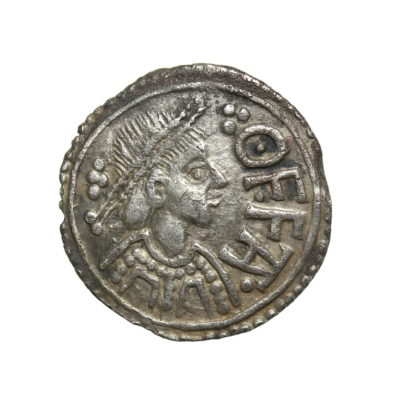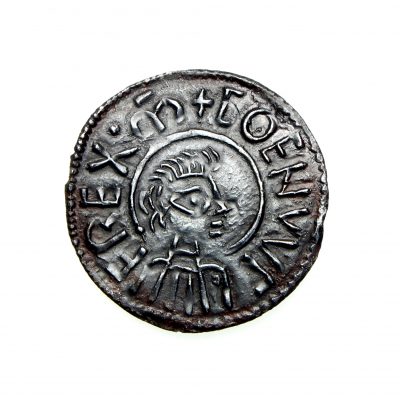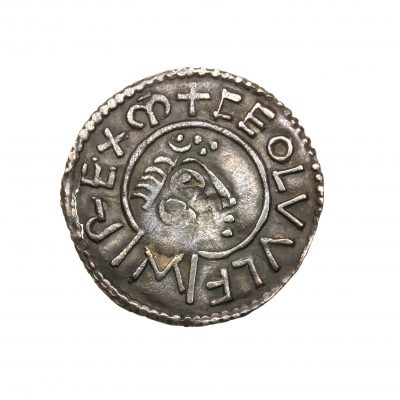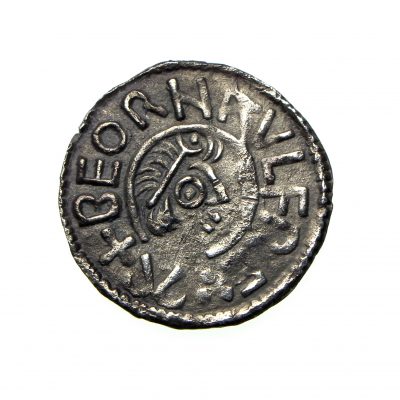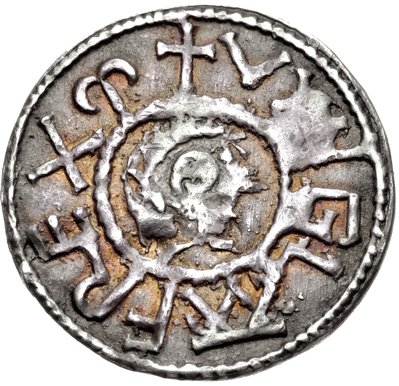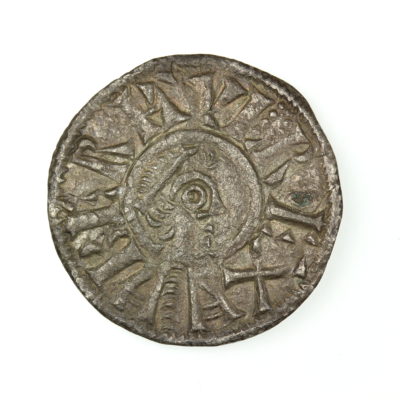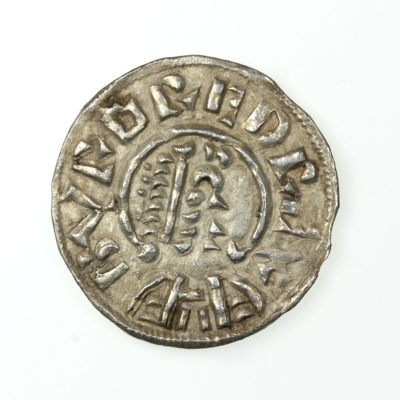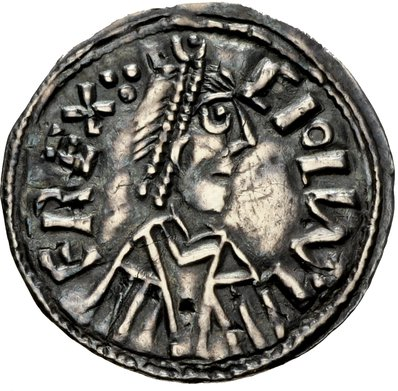Anglo-Saxon Kingdoms: Mercia
Ask a number of people in the UK to name one of the seven Anglo-Saxon kingdoms, and Mercia would perhaps be the most frequently mentioned. Although not a currently-existing county or administrative area like Northumbria or Sussex – irrespective, both a police force and British Army regiment are named after it. Overall, the legacy of Mercia seems to have done a better job of surviving in the modern collective memory. This can be at the very least partially ascribed to its famed eighth century king, Offa – who is widely regarded as the most powerful Anglo-Saxon King before Alfred of Wessex.
Occupying rather broadly around what is now the Midlands, Mercia’s ‘first town’ was that of Tamworth, followed closely by Repton. In addition to these, it also maintained control (both direct and indirect) over a number of other major settlements – including London, Canterbury, Rochester and Ipswich – which in addition to being major population centres and trade hubs were also important mint towns. As has been made evident in our other short coin notes describing the rise and fall of the other Middle Anglo-Saxon kingdoms, the kingdom slowly extended its power over most of those in southern England through the 7th and early 8th centuries; an insidious, creeping expansion which quickly changed to the application of direct control (enforced militarily, in many instances) by the mid-to-late 8th century. Historians refer to this period as the so-called ‘Mercian Supremacy’, and at its height one could walk across England (for example, from Gloucester to Thetford) – never leaving its territory. In part, this vigorous expansion can be connected with the relatively stable nature of Mercia’s ruling dynasty by comparison to at least some of the other kingdoms. Between c. 700-800, it is believed that Mercia was ruled over by five kings – of which two alone ruled for a combined total of 80 years! This picture of overall stability with occasional moments of crisis stands in stark contrast to the situation in Northumbria, where during the same period no fewer than 17 different monarchs are recorded to have reigned due to frequent internecine conflict.
Our story starts in around the year 757, when Offa succeeded to the throne of Mercia after a short but bloody civil war caused by the murder of the previous king, Æthelbald. Having taken the throne, he began a dual process of consolidating his own territories while expanding Mercian influence both at home and abroad. Documentary evidence records his controlling of the kingdoms of Kent and Sussex by the early 770s, with the western sub-kingdom of Hwicce possibly also disappearing due to Mercian annexation in this period. A part of this consolidation may have included the construction of what is now called Offa’s Dyke, a gigantic building project consisting an earthen bank broadly following the border between England and Wales. However, archaeological re-appraisal suggests this earthwork was begun in the late 5th century and repaired in places until the 10th. By the 780’s, conquest by warfare eventually turned to diplomacy – with Offa forging an alliance with the kingdom of Wessex by marrying off his daughter Eadburh to the new West Saxon King Beorhtric (whom he possibly sponsored as a puppet monarch). The same approach was also applied to Northumbria slightly later, with another daughter named Ælfflæd married to Æthelred I in 792.
Offa, as King of Mercia, not only extended his power within England but had connections with powerful figures on the Continent including Charlemagne and the Pope. It will therefore likely be of little surprise to readers in hearing that under Offa’s lengthy rule, a dazzling variety of different issues were struck – some of which take inspiration from foreign designs. These range from the currently unique gold coin imitating an Abbasid dinar of Muhammad Al-Mansur, to the ornate ‘Celtic cross’ types and delightful portrait issues struck at London, Canterbury and Ipswich. Offa is the first Mercian king who stamps his name on coins, and indeed he seems to have started this process with a bang. So complex is his coinage that new die-variants are still being discovered to this day, and even the seminal study of his coins by numismatist Derek Chick in 2010 is becoming slightly dated. Notably, Offa’s Queen, Cynethryth, also appears on coinage struck in her name – one iconic issue proudly proclaiming ‘CYNETHRYTH REGINA’, making her the only Anglo-Saxon woman to issue (and indeed, appear on) coins.
For all Offa’s power, fiscal shrewdness and diplomatic genius – even he could not cheat death. His demise in 796 and the subsequently short reign of his son, Ecgfrith, created a power vacuum that some of the more rebellious Mercian vassals took advantage of. Both East Anglia and Kent rose in rebellion, and it took several years of hard campaigning by the new Mercian king Coenwulf (a distant relative of Offa) to bring them back under control. Although these rebellions were put down, it is likely they shook the myth of Mercian invincibility in Middle Saxon England to its core.
Following Coenwulf’s death in 821, Mercia entered a decline that it would never truly recover from. His brother Ceolwulf succeeded him, but was deposed after a reign of just two years by the usurper Beornwulf. It is at this juncture that the decline turns to a period of crisis: defeated by Ecgberht of Wessex in the decisive Battle of Ellandun in c. 825, Beornwulf’s humiliating loss would be compounded by his second defeat in 826, fighting the newly independent East Anglians under their king, Æthelstan – a battle he would not survive. Coins of Beornwulf are very rarely encountered, but pale in comparison with his successor, Ludeca – of whom fewer than ten are known! Like his predecessor, Ludeca would die at the hands of the East Anglians in a vain attempt to re-take territory. After his death, the throne of Mercia was taken by a man called Wiglaf – who was quickly deposed and driven from the kingdom by the West Saxons. However, after a brief interregnum where Mercia was ruled directly by Ecgberht of Wessex, Wiglaf returned to rule again in c. 830. Whether this was by force or because Ecgberht had realised that the kingdom chafed too much under ‘foreign’ rule is unclear – but we do know that Wiglaf had some independence, striking his own coins (though these are somewhat rare) and issuing charters. One notable fact in reference to the latter is his instruction to the occupiers of some monastic houses, ordering them to construct ramparts for the purpose of defence. This is an allusion to the increasing boldness of Scandinavian raiders, who were already ravaging the coasts of Kent and East Anglia.
These incursions would intensify during the reign of Wiglaf’s successor – Beorhtwulf, who appears to have made a conscious effort to increase the production of coin in Mercia. Numismatists interpret this as an attempt at socio-economic regeneration and increased trade with Wessex, perhaps an attempt to further solidify their pre-existing ‘vassal’ based relationship in the face of the looming Scandinavian threat. Irrespective of the intent, it largely failed to make any meaningful impact. Although initially successful in putting down Welsh insurrections (as Offa had done many years before), Beorhtwulf was soon furiously firefighting as first Lincolnshire and then London (in 841 and 842 respectively) were attacked by large Scandinavian raiding parties. A further attack on London in 851 seems to have done irreparable damage, as output of coinage after this date from the city’s mint is much denuded. Indeed, the Anglo-Saxon chronicle records that Beorhtwulf and his army were put to flight, so vigorous was the Scandinavian advance. Interestingly, his date of death is not recorded – though it is traditionally thought to have been around c. 852.
Mercia’s last years as an independent kingdom are nothing if not tumultuous. The accession to the throne of Burgred in c. 852 was quickly followed by his marriage to Æthelswith, King Æthelwulf of Wessex’s daughter – perhaps demonstrating that the two kingdoms had by this stage totally put aside their previous enmity and realising that in order to successfully survive they must work together. This seems initially to have worked, as yet another rising by the Welsh was suppressed by a joint Mercian and West Saxon effort. However, the arrival of the ‘Great Heathen Army’, a Scandinavian force which overwintered in England in c. 865, changed everything. Though distracted initially by the tempting targets of first Northumbria and then East Anglia, by the 870’s Mercia was firmly in their sights. Despite an attempt by Burgred to pay them off, the Scandinavians sacked both Tamworth and Repton in 874 before driving him from the kingdom. Apparently accepting defeat and the fact that he never again would rule over Mercia, Burgred effectively ‘retired’ from public life – travelling to Rome and ending his days in the so-called Schola Anglorum, a sort of English pilgrim hostel instituted (allegedly) by the Kings of Wessex in the 8th century.
Back in England, the Danes crowned a Mercian noble called Ceolwulf to take his place, who would become Ceolwulf II – the last King of Mercia as an independent kingdom (albeit, a puppet). Very little is known about this Ceolwulf, though coin evidence of the rare and iconic ‘two emperors’ type penny demonstrates that he was briefly a close ally of Alfred the Great of Wessex, before his own death in the late 870’s. This may have been related to his status as a Scandinavian-sponsored puppet king, but whatever the reason – Mercia effectively ceased to exist as an independent entity after his death. Its heartlands were effectively split down the middle on the formation of the Danelaw (the area where Danish rule operated), though the concept of ‘Mercian’ identity and referral to that region as such seems to have persisted for some time. Indeed, references to ‘Mercians’ appear right up till the mid 11th century in various documentary sources.
The complexity and richness of the historical narrative of the Kingdom of Mercia is certainly equalled by its coinage. The sheer variety of coin-issuing monarchs and the various issues they struck make this a highly interesting yet challenging collecting area, with new die-variants also adding a highly academic aspect. Those hoping to assemble a full ‘set’ of Mercian monarchs may be disappointed – although issues of Burgred are reasonably common, some of the shorter-lived rulers are rare and may be difficult to acquire. In this regard, it is perhaps important to consider the rarity against condition and expense: although incomplete or fragmentary coins are often not particularly aesthetically pleasing, they can represent, nevertheless, a rare opportunity to fill gaps! In the collecting of Mercian (and indeed, any Middle Saxon) coinage – the pursuit of exclusively high-grade coins is not always the most fruitful path to take.

